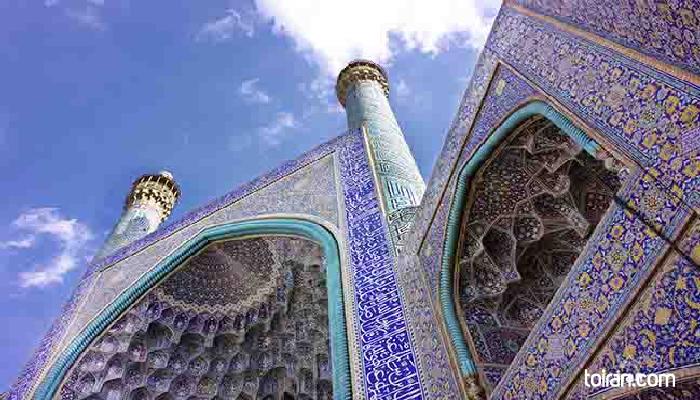On the south side of Naqsh-e Jahan Square sits the 17th century Imam (Shah) Mosque, which was built during the reign of Safavid ruler Shah Abbas I (1571-1629). The mosque, which is also known as Jame Abbasi Mosque and Royal Mosque, was intended to replace the Jame Mosque of Isfahan as the venue for the Friday Prayers.
Construction of the mosque began in 1612 in the 24th year of Shah Abbas’ reign. Iranian craftsmen invented the seven-color tile, which has a quicker and more cost-effective creation process, to use in the decoration of Imam (Shah) Mosque. It is said that 18 million bricks and 475,000 tiles were used in this mosque.
The 27- meter-high entrance of the mosque, which opens to Naqsh-e Jahan Square, is bound by two 42-meter-high minarets and has multi-color tilework with flower and bird motifs as well as mo’arraq tilework.
There is a white on Persian blue Thuluth inscription above the entrance, which is the work 17th century master calligrapher Ali Reza Abbasi. The main door of the mosque is made of gold and silver and has a Nastaleeq inscription with eight verses of poetry.
Renowned polymath Sheikh Baha’i (1547- 1621) designed this mosque to have the biggest dome in the city, to be visible from any point in the square and to have a winter mosque and two religious schools on either side.
The double-shell dome of the mosque sits on an octagonal dome chamber and is considered the biggest and most finely-decorated domes of the 17th century. This dome is 52 meters high and has been designed to reflect sound. The two shells of the dome are 16 meters apart. The interior of the dome has been decorated with multicolor tiles and gives viewers a sense of spiritual transcendence.
The Mihrab (prayer niche) of the mosque is considered one of the most beautiful prayer chambers in all of Isfahan and has extensive blue tilework.
In the main courtyard of the mosque an indicator stone has been placed by Sheikh Baha’i that can determine the exact time for noon prayers on every day of the year.
This mosque, which was designed so that travelers on the Silk Road could see its turquoise dome glittering like a gem from miles away, is also depicted on the back of the 20,000 rials banknote.
The Mosque has been registered along with Naqsh-e Jahan Square as a UNESCO World Heritage Site.







Among the most beautiful Mosques in the world are Sheikh Lotfaolah and Imam Mosque both in the Naqshe Jahan square (all UN registered heritage sites). Make sure you visit the mosque while visiting Isfahan. the amount of detailed art done in this mosque will make any visitor wonder :)
مسجد امام یا همان مسجد شاه سابق واقعا شاهکار هست. فضای صحن که صدا می پیچد و بلندی طاقهای هر صحن که پوشیده شده با کاشی های فیروزه ای هست واقعا زیباست. همه اصفهان را با این مسجد و این کاشی های می شناسند.